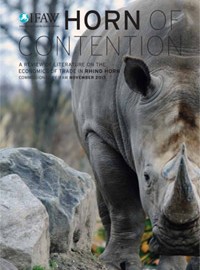Poaching of rhinos in Southern Africa has increased dramatically in recent years. There is considerable debate within policy circles and the conservation movement as to the best policy response to increased poaching. Because many of the factors driving poaching and illegal trade in rhino horn are economic, many stakeholders are looking to economics for potential policy responses. In particular, there are suggestions that a legalised, heavily regulated trade in rhino horn could reduce rates of poaching.
This paper is a review of studies on the economics of trade in endangered wildlife in general and on rhino horn in particular. Two studies reviewed are from formal academic literature and another four are less formal articles or “grey literature”. The formal studies are from peer-reviewed journals, but do not explicitly address the recent increase in rhino poaching. The grey literature are less rigorous, but have the benefit of focussing on recent events in Africa.
The formal studies suggest that predicting the outcome of liberalising trade is complex and difficult to determine. Although it may decrease pressure on poaching, as rhino horn becomes increasingly supplied through the non-lethal legal trade, there is also a real risk that trade could drive an increase in poaching through any combination of five mechanisms:
- Through legal and illegal markets coexisting and interacting in complex ways.
- Through reducing the stigma attached to consumption of the product.
- By potentially reducing the supply costs of illegal supply.
- By potentially facilitating the laundering of illegal supply in with legal supply.
- As a result of uncertainty around the response of illegal suppliers to competition from a legal market.
The articles from the grey literature are all overtly pro-trade, generally assuming that:
- Legal markets will “hijack” consumers from illegal markets and that legal and illegal horn would be perfectly substitutable.
- Stigma effects are small and that efforts to reduce demand through education and information would be ineffective.
- Increased surveillance funded by rhino horn sales would increase poaching costs.
- Technical advances such as DNA technology would minimise laundering.
- Smugglers with market power would respond to the introduction of a legal trade passively, accepting reduced sales, rather than competing to retain market share.
Little empirical evidence is offered to support these views. Under certain conditions these assumptions may hold, but it is unclear if these conditions are in place in either supplying or consuming countries. We suggest further research should be undertaken before any formal steps are taken towards legalising trade in rhino horn.

